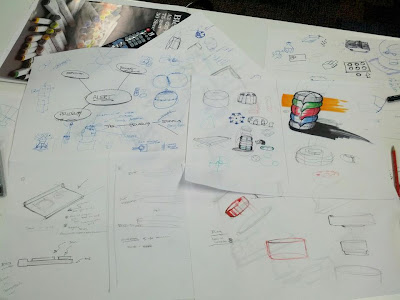Theme: "Designing for Interaction"
Introduction
This week's lecture discussed theories and research relating to design led interaction and human behaviour. The speaker talked primarily about two different approaches to interaction design, these include the semantic approach and the action-centered approach. The semantic approach is a physical representation of digital information. For example an object that interacts with its external environment and creates a noise can be considered to be employing a semantic approach. The object is a container of digital information and is relaying a noise which can be transformed into a musical composition. An action-centered approach involves the kinetic movements or some type of human movement. This approach is explained as the carrier of information and a form of self expression.Both of these approaches may be used by a designer in an attempt to build on people's everyday embodied skills and way of knowing. Furthermore, the speaker stated there is now a move away from the cognitive focused design approach to a further in-depth look into physical interactions and the role they may be able to serve.
It is my understanding that tangible interaction design is about focusing on ways of improving people's skills and experiences through their natural behaviour and predetermined abilities. New products are constantly being released onto the market but there is still a barrier that some users face when it comes to understanding how to operate a product. This process can be daunting and for others simply frustrating. This is where I believe interaction design is able to remove this barrier to learning and utilize people's own natural instincts and abilities in order to help them better understand how to use a product.
Another point which I found to be thought-provoking was this idea that interesting actions equals difficulty. However, this does not necessarily mean designers should stay clear of such knowledge, but rather use this information to allow users to gain an emotional connection with a product. This emotional connection could possibly be one which creates a sense of challenge and motivation for the user to learn and succeed. Learning should not be an easy step by step guide with lengthy descriptions but preferably a stage of curiosity and development.
Tutorial Exercises
This week our design team had a meeting to discuss our semester's project - 'sensing the news.' Our original concept was an office management system which would be used by a company to organise their projects and delegate tasks to employees. The idea behind it was to allow managers and C.E.O's to manage, control and regulate work load to allow a more efficient office environment. However, after talking with certain tutors we found that our concept lacked a well-resolved scenario and human behaviour. We were told that these areas needed more refinement and further development. The team took this feedback on-board and began to break down the original concept and identify possible alternatives and new applications.
We decided to begin the tutorial by brainstorming some initial ideas and start generating new concepts and ideas. In regards to my individual concept my idea still related to the context of an office space but focused more on the human interaction aspect. Firstly, I looked at repetitive behaviours that are performed on a day-to-day basis by a majority of office workers. This repetitive behaviour was identified as typing. As a result, my concept involved a flexible typing board which uses vacuum suction and audio to alert employees of tasks and outstanding projects. The board works through a wireless receiver which collects information sent from the manager and displays it through audio, light and pressure.
When a task arrives a button simply lights up with an accompanied audio sound. When the task is urgent and has not yet been successfully completed, the pressure in the board will increase causing a specific button to rise up. This notifies the employee that they need to finish the task soon. The board suits the context well as it could be easily integrated into the context with minimal disturbance or need for new systems or infrastructure.
The other concept of mine related to the same idea but a new application. The same flexible board could be placed on the ground underneath an employee's feet. This application appears to be less invasive of an employee's personal space and a provides them with more space on their desk to work. The board works exactly the same way with lights, audio and pressure but it replaces the user's hands and gets them to use their feet as the control mechanism. This application builds on the previous design by looking at this need for people to express themselves and show their emotions. When a task is not completed and a button on the board begins to rise, the user is able to gently hold their foot on it to show they are calm and in control or they are able to stomp on it in order to release their frustration.
The best aspect of this design is the fact that the object relies on the user to interact with it in order for it to work effectively. Without the user, the product would be obsolete and unable to function properly. As stated in the lecture, skill is not just about the individual but of the total field of context. Users gain skills from the content and learn through association. This concept encourages users to learn through interaction and association. User's are able to use their board differently to their other co-workers depending on their emotional state at the time.
Below are some images of the group's work and the overall concept which will be presented in week 9:

.JPG)




No comments:
Post a Comment